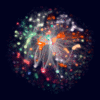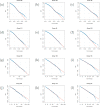Emergence of knowledge communities and information centralization during the COVID-19 pandemic
- PMID: 34364158
- PMCID: PMC8417351
- DOI: 10.1016/j.socscimed.2021.114215
Emergence of knowledge communities and information centralization during the COVID-19 pandemic
Abstract
Background: As COVID-19 spreads worldwide, an infodemic - i.e., an over-abundance of information, reliable or not - spreads across the physical and the digital worlds, triggering behavioral responses which cause public health concern.
Methods: We study 200 million interactions captured from Twitter during the early stage of the pandemic, from January to April 2020, to understand its socio-informational structure on a global scale.
Findings: The COVID-19 global communication network is characterized by knowledge groups, hierarchically organized in sub-groups with well-defined geo-political and ideological characteristics. Communication is mostly segregated within groups and driven by a small number of subjects: 0.1% of users account for up to 45% and 10% of activities and news shared, respectively, centralizing the information flow.
Interpretation: Contradicting the idea that digital social media favor active participation and co-creation of online content, our results imply that public health policy strategies to counter the effects of the infodemic must not only focus on information content, but also on the social articulation of its diffusion mechanisms, as a given community tends to be relatively impermeable to news generated by non-aligned sources.
Keywords: Global Communication; Infodemic; Public Health.
Copyright © 2021 Elsevier Ltd. All rights reserved.
Conflict of interest statement
The authors declare no competing financial interests and no conflict of interests.
Figures









References
-
- Abel G.J., Sander N. Quantifying global international migration flows. Science. 2014;343:1520–1522. - PubMed
-
- Allen D. University of Chicago Press; 2016. Education and Equality.
-
- E. Bakshy, B. Karrer, L. A. Adamic, Social influence and the diffusion of usercreated content, in: Proceedings of the 10th ACM Conference on Electronic Commerce, pp. 325–334.
-
- Barber′a P., Jost J.T., Nagler J., Tucker J.A., Bonneau R. Tweeting from left to right: is online political communication more than an echo chamber? Psychol. Sci. 2015;26:1531–1542. - PubMed
-
- Bergstrom A., Jervelycke Belfrage M. News in social media: incidental consumption and the role of opinion leaders. Digital Journalism. 2018;6:583–598.
Publication types
MeSH terms
LinkOut - more resources
Full Text Sources
Medical
Research Materials
Miscellaneous

